When you have a hammer, everything is a nail. This extends to most things in life, including self-defense. Unfortunately, some people that carry firearms feel this way too.
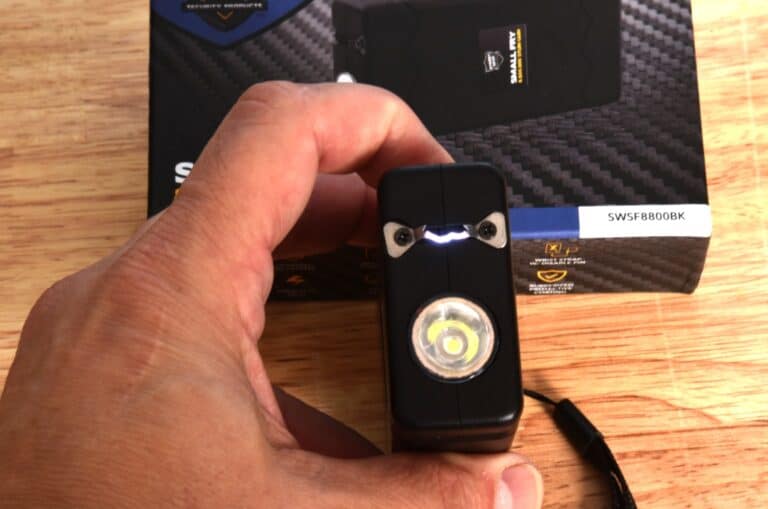
What most don’t realize is that self-defense is a continuum. This continuum starts at walking away and ends at lethal force.
In between, there is a lot of room for non-lethal actions. Within this range may be a place for your deployment of a stun gun. Non-lethal and potentially debilitating, stun guns can effectively stop or deter a threat.
Like much in life, there are many considerations before you decide if a stun gun is for you. Let’s look at these, as well as the top 5 stun guns currently available.
Stun Guns Defined
Generically, stun guns, and similar devices (e.g., tasers), use an electrical charge to cause pain or neuro-muscular interruption. Used as less-than-lethal defense, they reduce the capacity of an attacker to cause you harm.
Most devices of this type are high voltage, low amperage, compact, easy to conceal, and easy to carry. Stun guns are contact weapons.
You may use other devices at a distance, much like pepper spray. With a stun gun, the opportunity for escape has passed. Your attacker is hands-on.
Being electronic, they require a battery and have limited use cycles before you need to replace or recharge the batteries. That requires a little maintenance, but only plugging yours in once a week to keep it charged.
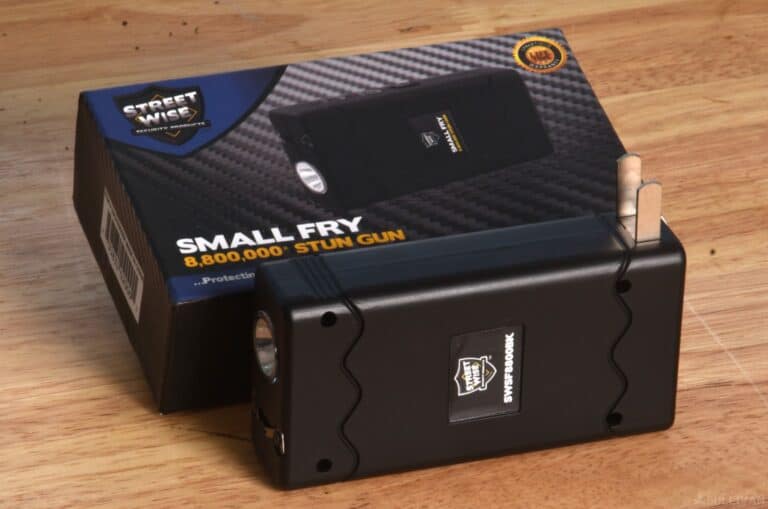
A rechargeable Streetwise stun gun. This device plugs directly into a 110V wall outlet.
There are a wide variety of types, form factors, and voltages/strength. Let’s look at a few of these before making our recommendations.
Stun Guns vs Tasers
We often group stun guns in with tasers although they are fundamentally different.
Stun guns are usually small contact devices (e.g., you must touch the aggressor), and rely on pain for compliance.
Tasers or “Thomas A. Swift Electric Rifle” are shaped like firearms, are noncontact, and disrupt the neurological and therefore muscular system of your attacker.
Stun guns have two or more electrodes, between which a low current but high voltage electrical charge passes.
The goal is to get the electrodes in contact with a person or press the electrodes into their clothing such that there is contact with the skin.
Once you make contact, the trigger is depressed, thus lighting up the attacker. This results in short-duration, localized pain. With luck, this leads to their retreat.
If you do not contact the attacker, an arc passes between the electrodes. While not physically effective, the sight and sound can be motivating.
Stun guns come in a variety of form factors, from the size and shape of a deck of cards to a wand/flashlight, and even a cell phone case. Some include lights and sirens.
Tasers, as stated, are distance devices, albeit short distance. The electrical current passes between two probes. A charge of compressed gas launches the probes tethered to the taser via thin, flexible wires.
Using a taser requires attention to accuracy as both probes must hit the target and you only get one shot before re-loading the taser cartridge.
Once the barbed probes have attached to the attacker, the electrical charge passes through the subject. Specifically, it passes through all the meat between the probes.
The voltage is large enough that, if the probes are separated enough, the electrical charge disables the attacker via a massive neuromuscular response.
Most tasers are shaped like pistols. Being a non-contact device, your mastery of grip, stance, and sight alignment all come into play.
Most tasers have maximum distances of 15-25 feet. Under stress, the required accuracy takes practice.
The Risks of Non-Lethal Defense
While non-lethal, both devices are not foolproof. First, is the question of effectiveness. Stun guns vary in strength. The pain they inflict varies from a mild bee sting to searing and incapacitation pain.
At a recent counter custody class with Ed Calderon, part of the “practical exam” was about 15 minutes designed to increase your anxiety and blood pressure.
I lost count of how many times I got tagged with a stun gun, but it was north of 20. I wouldn’t call the experience pleasant by any means.
It was, however, something that I could muscle through and continue with the rest of the event.
That being said, every time someone walked by (we were all blindfolded) my pulse shot through the roof in the anticipation of another zap.
The sensation of this particular stun gun (similar to the one in the image below) was akin to a bee sting that instantly faded. I can certainly imagine how “altered” people (by drugs or mental state) can be completely unphased by such a device.
Unless the attacker is extremely frail or has other underlying severe conditions, stun guns are completely non-fatal. Tasers, on the other hand, can go beyond their non-lethal intent.
The last risk of both devices is their use against you. Just like pepper spray, you must also prepare for its effects. If your attacker gets ahold of your device, you need to be prepared to take the hit.
Always seek training on any device you use for self-defense. A good class will teach you how to use one and safely expose you to being tagged.
Critical Factors In Stun Guns
There are several factors to consider when you must trust any device for your protection. Stun guns are no different.
The first consideration is voltage. Much like range when considering blister pack FMS or GMRS radios, you must take the claims of the manufacturer with a grain of salt. Voltage statements are often misleading or outright false.
Do your research. Sabre Red has a great article with a chart from the National Institute of Justice (NIJ) on several popular stun guns.
Next is form factor. How and where you will store it? How do you plan on retrieving it? Do you have physical limitations for their deployment and presentation? These questions factor into what you purchase.
Will you keep one in your hand while jogging? Do you plan to keep it in a bag or purse? Do extras such as sirens or high-lumen flashlights factor into your non-lethal defense options?
Stun guns come in several shapes and accessory packages. Some are small and blocky. These are ideal for a small pocket or hand. Others look like flashlights.
These may be best for a belt or purse holster and may probably pass a cursory inspection and be allowed into an area where they would otherwise be restricted.
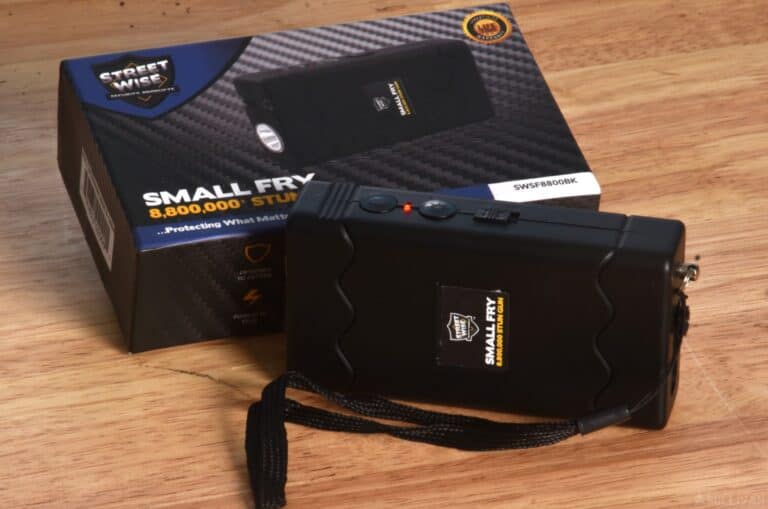
A compact low-output stun gun.
Finally, you must consider the legality of stun guns. Many jurisdictions do not allow for stun guns, pepper spray, or other non-lethal forms of self-defense for their citizens. Check your local laws before you purchase and carry any such defensive device.
Top 5 Stun Guns
Disclosure: This post has links to 3rd party websites, so I may get a commission if you buy through those links. Survival Sullivan is a participant in the Amazon Services LLC Associates Program. As an Amazon Associate, I earn from qualifying purchases. See my full disclosure for more.
Let’s look at the top 5 stun guns across the full range of pain delivery.


1. Streetwise Security Products Small Fry
Starting at the low end of the “light up my night” scale is the Streetwise Small Fry. Reported at 0.187 micro coulombs by the NIJ.
This is the same stun gun they tagged me with, many, many times, during the counter-custody practical exercise. I didn’t like it. The sound intimidated me.
But I can’t say that it was all that terrible. I’m still here today to write about it.
The Streetwise uses a rechargeable battery and plugs directly into the wall to charge. It also includes a dazzling flashlight that is a deterrent all by itself. It has an integrated safety switch and a disable key (attached to a wrist strap).
The Streetwise has a simple form factor and is slightly larger than a deck of cards. There are only three controls: activation switch, flashlight button, and stun gun trigger.


2. SABRE Tactical Series Stun Gun with Flashlight
The SABRE Tactical Series stun gun packs a pain-inducing .76 micro coulombs as rated by the NIJ and reported by SABRE.
This flashlight-shaped stun gun has two electrodes in front of the lens that are activated with a trigger switch.
The first button activates the 130 lumen LED, the second triggers the electrodes. It also comes with a nonslip textured grip. The base of the light contains the safety switch as well as the charging port.


3. Guard Dog Security K-Tana
The Guard Dog Security K-Tana is a larger flashlight-styled stun gun that outputs an intense 0.987 micro coulombs.
I carry and have used a bright flashlight for self-defense. The 400 lumen LED is enough to cause a reaction even under full sunlight. The bezel of the light is a strike surface that doubles as the electrodes.


4. VIPERTEK VTS-880-30 Billion Mini Stun Gun
The Vipertek VTS-880-30 is a small stun gun, about the size of the Streetwise. It also can produce unbearable pain with 1.043 micro coulombs.
The form, fit, and function are identical to the Streetwise. It is a little larger than a deck of cards, plugs into a 110v outlet to recharge, has a slide switch that doubles as the LED on switch.
Finally it has a button that activates the electrodes. The Vipertek does not have a disable key.


5. SABRE 2-200SF
The SABRE 2-2000SF is the highest-rated of this list with 1.82 micro coulombs that the NIJ states will induce unbearable pain.
This stun gun effectively disguises itself as a 120-lumen flashlight. Bright lights aside, the electrodes around the bezel pack the punch.
As with all the others recommended here, the SABRE is re-chargeable.
Using a Stun Gun
The biggest disadvantage of stun guns is that they are contact weapons.
Given the choice between touching an attacker and remaining at arm’s length, I’ll take distance any day. That being said, we don’t always get what we want out of life.
Next, realize that stun guns are weapons. They are designed to inflict pain in order to dissuade or temporarily disable your attacker. These are not party favors, or toys to prank your buddy. Use only on legitimate threats.
If you have enough warning, you can always use a stun gun at a distance as a deterrent.
The sound and sight of an active stun gun leave no doubt that you are capable and mean business. Many attackers, in their right mind, will flee at the first sign of resistance.
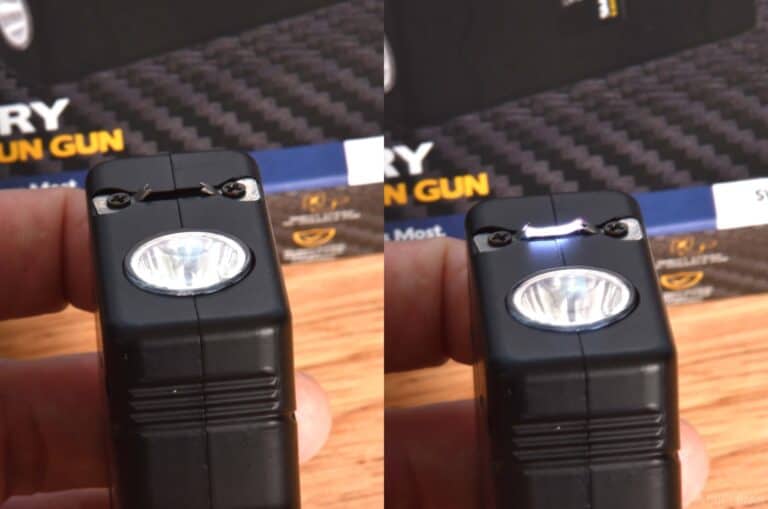 The arc between the electrodes of a stun gun.
The arc between the electrodes of a stun gun.
If that does not stop the aggressor, or they are on you before you can light up the stun gun, contact is your best option.
Press the stun gun into any flesh or lightly clothed area you can find. If you have the option, target the ribs, just below the ribs, shoulder, buttocks, and hips. Press hard and hit the trigger!
You won’t see or hear the spark. The electrical current is passing through them and not the air.
Keep on the trigger until your assailant backs off. As soon as you have an opening retreat! Gain as much distance as possible!
If you can’t get that perfect target, or the stun gun is having little effect, hit somewhere else.
You may not have good contact or they may have clothing that is too thick. A thick Carhart or leather jacket may provide some insulation against the shock.
Go for hands, legs, whatever is close. Zap it and keep zapping it. Hit anything and everything until you get a response that signals they are getting the message.
One final warning on stun gun usage. Just like any defensive tactic or tool, they aren’t 100%.
There is a segment of the population that will simply brush them off. These people include those with high pain tolerance, those that are so driven by anger or otherwise, that they will work through the discomfort.
The other class of individuals stun guns may have a limited effect upon is those that are altered via alcohol or drugs.
We’ve all heard the story of the altered person who continues to attack after being shot multiple times. Your stun gun may have little to no effect on this type of attacker.
Wherever possible, always analyze your threat before deciding on a plan of action. That being said, I recognize we aren’t always given this chance.
When in doubt, fight hard! Swift, overwhelming violence is sometimes the only solution.
Taking Charge of Stun Guns
I firmly believe in everyone’s fundamental right to self-defense. Everyone that is able, should have the means, training, and will to protect themselves as well as those that are in their charge.
That being said, defense is a continuum that starts with avoidance and ends in lethal means. As I said, it’s a continuum. It’s not either-or.
A part of that scale is non-lethal defense. When presented with a non-lethal attack, you have no right to use force that will cause death or grave bodily harm. You are legally obligated to only use up to reciprocal force.
When an attacker confronts you with little or no possibility of doing great bodily harm, a stun gun is a great option for dissuading the attacker. From the sound to the induced pain, they are sure to turn them around.
Take a look at the risks and benefits of carrying a stun gun to see if there is a place for one in your arsenal.
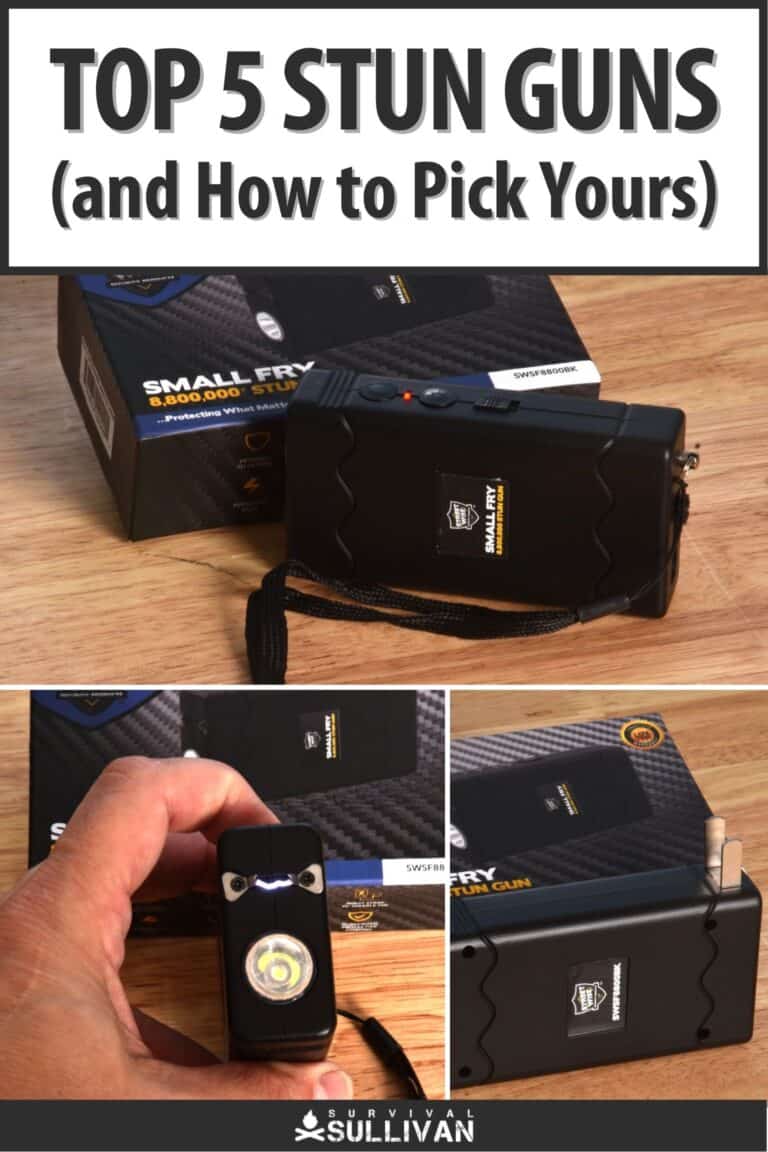
The post Top 5 Stun Guns (and How to Pick Yours) appeared first on Survival Sullivan.
By: M. I. Grey
Title: Top 5 Stun Guns (and How to Pick Yours)
Sourced From: www.survivalsullivan.com/choosing-a-stun-gun/
Published Date: Wed, 01 Feb 2023 16:00:00 +0000
-------------------------------------------------------------------------
Did you miss our previous article...
https://outdoorsnewswire.com/survivalist/4runner-upgrades-westcott-roof-rack-baja-designs-lights-amp-spod
 CampingSurvivalistHuntingFishingExploringHikingPrivacy PolicyTerms And Conditions
CampingSurvivalistHuntingFishingExploringHikingPrivacy PolicyTerms And Conditions
